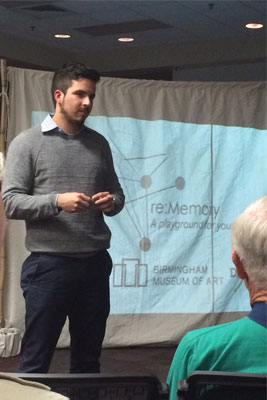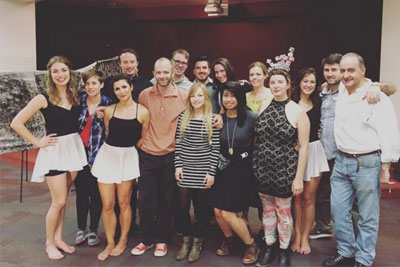The average human brain weighs about 3 pounds and contains 80 to 100 billion neurons, which are the cells that store information. But how do these cells store information? How do we retrieve that information? How do researchers study memory?
Mika Guzman Karlsson, an MD/PhD candidate from the Sweatt lab, and Megan Rich, a PhD student from the Bolding lab, both from the Department of Neurobiology, described how memories are stored and retrieved at the Discoveries in the Making event at the Homewood Library on April 14, 2016.
 Step 1: Encoding
Step 1: Encoding
Much of what is known about memory and the brain comes from clinical case studies. Through these studies of different patients, it was discovered that distinct brain regions are important for distinct memories. From Patient HM, the importance of the hippocampus for episodic memory was revealed. From other studies, the link between the amygdala and fear memory was found when patients exhibited a lack of fear.
Approximately 30 percent of neurons are dedicated to learning. With each experience, a different population of neurons is involved for storing that memory. It is possible to bias which neurons will store a memory, which results in the co-storage of similar memories. For one memory, different neurons may store information for sight, smell, and sound. These same neurons may also be part of a different memory with a similar smell or sound.
Growing up in Bolivia, Guzman Karlsson can remember the sights, smells, and adventures of his childhood. He shared a picture of himself dressed like a clown to help illustrate how memories are stored and retrieved. When he was dressed up as a clown, particular neurons were activated, storing the relevant information. When he was on vacation with his family, different neurons were activated to store those memories.
Step 2: Storage
Within the cell, many processes are involved in memory storage, or consolidation. Electrical activity comes down the cell and causes the release of neurotransmitters, which bind to the post-synaptic cell and send information to the nucleus. This information will cause the cell to make new proteins, resulting in a larger post-synaptic cell with more protein receptors and more structures on the synaptic spine.
To help explain this concept, Rich used the same example of Guzman Karlsson dressed as a clown. If he was trying to remember the picture and thought the pompom on his hat was white, but when he looked at the picture, he saw that the pompom was actually black, this memory would be reinforced and strengthened by making new proteins, resulting in a larger synaptic spine.
Step 3: Retrieval
During reconsolidation, or accessing memories, the structural proteins and receptors will disappear, information will be sent to the nucleus and as a result, more proteins will be made, strengthening the memory.
 Multiple areas of the brain may need to be activated in order to retrieve memories. It is also possible to weaken memories by using drugs that prevent the shuttling of proteins to the post-synaptic cells. This process may be beneficial in cases of post-traumatic stress disorder or other similar traumatic events.
Multiple areas of the brain may need to be activated in order to retrieve memories. It is also possible to weaken memories by using drugs that prevent the shuttling of proteins to the post-synaptic cells. This process may be beneficial in cases of post-traumatic stress disorder or other similar traumatic events.
re: Memory
Several UAB neuroscience students have made an effort to combine art and neuroscience. Following the scientific talks, re:Memory Birmingham presented an artistic rendering of the processes of memory. Dancers and musicians explored experiences related to the concepts of memory retrieval, memory storage, and the modification of memories. This performance bringing art and science together in the community surely activated neurons and created memories for all in attendance.